So, when we say “messaging”, we don’t directly mean SMS or text messaging (although this can play an important part in your strategy, depending on your target audience, your brand identity, and so on).
No. Product messaging is the message your product sends to potential customers. Sounds simple right? Well, its definition may be, but getting the right message out there in the right way can be difficult. Most people think the foundation of their message is listing a bunch of features and benefits, and while those things do need to be defined, they shouldn’t be where you start developing your product messaging.
How people perceive your product is a direct result of messaging. The right messaging effectively communicates your product’s value, giving prospects an understanding of how your product solves their specific problem.
Your messaging will also provide strategic guidance to PR teams, external marketing communications, and your sales team. And when you’re all speaking the same language, your messaging becomes more powerful and recognizable as it’s consistently applied across all media.
In this guide, we'll be answering key questions like:
Messaging unpacked
You might know why your product is perfect for your prospective customers, but without effective positioning and messaging it’s unlikely they’ll know or bother to find out.
Clearly, developing your positioning and messaging is vital to your product’s success. It’s the reason why you immediately think of Coke when someone mentions cola, it’s the reason why you’d think of a Volvo if we asked you to picture a safe car, it’s your prospect’s initial perception of your product.
Positioning and messaging go hand in hand, you simply can’t have one without the other, but how do we define messaging? Let’s start at the beginning.
What is product messaging?
Put simply, it’s the message your product is sending to your potential customers. Developing the right messaging requires a lot of research and while there isn't one, definitive format for doing so, we have a bunch of articles and resources that can guide you in the right direction.
You can communicate with your audience through a multitude of different messaging techniques:
- Social media posts,
- Website chatbots,
- Advertising or marketing campaigns,
- Podcasts and webinars,
- Product design or layout,
- In-app notifications,
- CTAs (call-to-actions),
- And plenty more.
Why is product messaging important?
How people perceive your product is a direct result of messaging. The right messaging effectively communicates your product’s value, giving prospects an understanding of how your product solves their specific problem.
Your messaging will provide strategic guidance to PR teams, external marketing communications, content marketing, and your sales team. And when you’re all speaking the same language, your messaging becomes more powerful and recognizable as it’s consistently applied across all media. Good messaging will prove vital when crafting a market nurturing campaign, and having a cohesive message you can apply throughout your content and communication will lay a solid foundation for lead conversion.

Messaging vs positioning
You might be wondering, what is the difference between messaging and positioning?
Positioning is the foundation on which messaging is built, and determines the place a product sits within the market. This is important as it gives your customers the context of where your product fits into their view of the product landscape.
Messaging is how you communicate the benefits of your product to your customers. The position sets the strategy and the messaging brings your story to life. This allows your customers to understand more about your product.
What is an example of a product message?
If you're struggling to work out what an excellent product message looks like then you're in for a treat, as we've compiled a few examples of successful product messages.
Webflow
Webflow is a web design software which allows its users to tell its product message by having testimonials visible on their main landing page. Testimonials and reviews tend to appear more genuine to customers, so are a great way to share the benefits of your product.
Vidyard
The video messaging solution, Vidyard, allows customers to choose the pain points they are struggling with (that Vidyard could solve), showing that they understand their customers. And shows customers how their service can help.
What is a product marketing messaging framework?
A product marketing messaging framework plays a key role in every product marketing team's artillery. It serves as a representation of your products and services unique selling points.
It's a vital resource that supports creative briefs, content, and training for your sales representatives.
How to create product messaging
You know that old teaching method of show and tell? Well, when it comes to product messaging you’re going to flip it on its head. Once you’ve settled on your product’s core value you’re going to back it up by becoming your own case study. Demonstrate your product, allow consumers to test it out themselves, ask for feedback, and if you can’t be your own case study get some beta testers involved and ask for honest feedback.
Research is a huge part of developing your messaging. As you learn more about the people who will be using your product, you’ll naturally learn more about the companies they work at, and be able to refine and target your messaging accordingly.
Once you figure out the value of your product and who your target audience is, you can use that information to craft your product messaging, starting with why the consumer should buy your product while demonstrating how your product’s features improve their lives and address their specific pain points.
Demonstrate your value
Once you’ve settled on your product’s core value, show potential customers what that value looks like in real life. You could use a case study to demonstrate the value your product provides. Many SaaS companies do this using their own products.
Take Vidyard for example, they send personalized videos to interested buyers to demonstrate what their software can do, they also offer a ton of video content to engage with while prospective customers wander through their website.
If you can’t be your own case study, find a group of beta testers who will provide you with honest feedback, and then use that feedback to determine and refine your product message.
Research the market and develop buyer personas
Now you’ve experienced how users gained value from your product you need to research what type of customer or business will be able to gain similar value.
Once you identify who can benefit from your products, draft your buyer and/or user personas and apply that to messaging that resonates, based on what you learned in the previous step.
Find out how your product can help your personas, and ask yourself who will be making the purchasing decision? What will your end-user need to convince them to make the purchase?
As you learn more about the people who will be using your product, you’ll naturally learn more about the companies they work at, and be able to refine your ideal customer profile (ICP) based on the companies that have the most success with your product.
Emma Stratton, Founder and CEO of Punchy.co, shares her expert insights into using your customers' words to make your message sound more genuine.
"Authenticity is key to creating effective messaging that builds your brand. No one wants to read dry, corporate messaging or bravado, we crave realness - our favorite brands speak our language, they’re human.
"That’s why more and more B2B companies are investing time and resources into brand voice development to strike the right tone with their customers. But there’s a quick, low-impact way to get started. Let your customer do the work for you – steal their language (in the nicest possible way, of course). It’s the ultimate shortcut to crafting messaging that resonates with your customer - a cheat code.
"When you take the words right out of a customer’s mouth, you make it easy for other customers to understand why your product matters. For example, I had a client whose platform integrated several sales tools into (the ubiquitous phrase) 'one pane of glass.' But that’s not how their customers described the integration. Instead, they all said “now I don’t need multiple tabs open” – so we used that phrase instead, and it resonated.
"So how do you find juicy, steal-worthy language? Simply run customer interviews. Here are some of my top questions to ask:
● How would you describe our product to a friend? This question is perfect for complex products – customers have a knack for keeping it simple, and may give you a new way to describe your product.
● What was happening in your world that made you seek out a solution in the first place? This gives you a real insight into what motivated a customer to change. These offer meaningful challenges and pain points to mirror in your messaging.
● How did your life change, thanks to the product? This is a great way to capture new and meaningful benefits. I’ve worked with clients who discovered their new value proposition from this question.
"If you don’t have time for customer interviews, head to product review sites like G2, TrustRadius and Capterra. Check out reviews for both you and your competitors and highlight any interesting phrases – especially repeated ones or you can listen to conversations on software like Gong, Chorus.ai or SalesLoft if you have it.
"But, in my experience, nothing beats a good old one-to-one interview."
Add it all together
Once you know the value of your product and who you’re trying to market it to, you can use it to craft your product messaging.
Start by explaining why a potential customer should buy your solution. This should be spelled out through your product’s core value. You then need to explain why they should buy your product specifically, which you’ll demonstrate by showing how your product’s features and benefits specifically address the customer’s pain points.
You may need to present your value proposition in a different way, depending on the personas you’re addressing but your core value should always stay the same, even if the benefits you are highlighting change.
Remember: Three key principles
The simplest way to think about product messaging is with the three key principles. Stephanie Perezo, Senior Product Marketing Manager at Contentful, shares some key insights on this topic.
"What I've learned is it comes down to these three key principles; categorize, atomize, and curate your messaging.
"You can apply any of these three principles today, or at any point of your messaging journey. My recommendation would be to do them all together if you can - if you have the time and the space to do so.
"Nevertheless, if it seems this is a very daunting task and a monumental effort then applying any one of these principles will still get you a very long way.
"Let's dive into each one of these."
1) Categorize
"Categorizing is really about building a taxonomy for messaging.
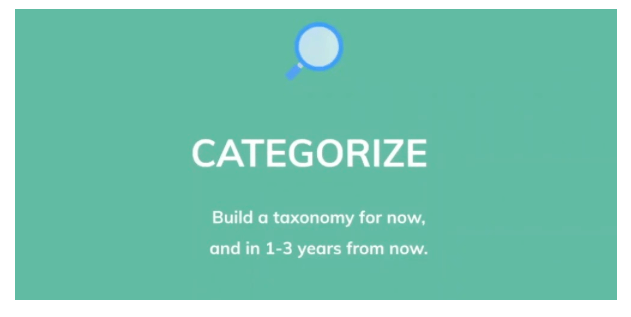
"Having worked in the Digital Asset Management space at Bynder, I know the word taxonomy can seem like a very scary thing.
"But really, you've already done this at the point you've built out your product marketing messaging framework and positioning framework. In your messaging and positioning framework, you've probably built out top-level messaging supported by your value proposition, some key unique selling points, capabilities, and features. There you have it, half of the work is already done.
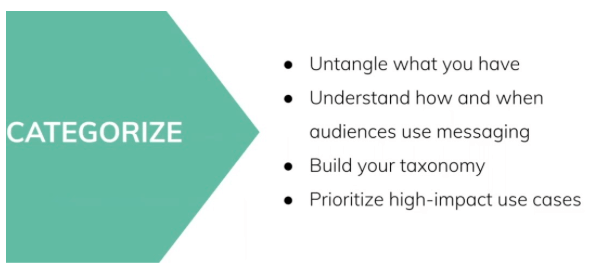
"But there's more. Categorization is about grabbing that foundational messaging document and untangling it to fit common themes or buckets based on how your audience will use it.
"For this exercise, I'd recommend starting with some key use cases with the highest impact. For example, sellers are your number one partners in crime so you need to understand where they struggle with your messaging today, so you can simplify it and organize it and make it easier for them to find and use.
- Getting clear on how you speak about your product is one bucket.
- Your differentiators or your unique selling points is another bucket.
- Key use cases and solutions, that's a completely separate bucket.
- Marketing is also your key stakeholder.
"You can't expect everyone in your marketing team to know the product or the customer or the market as well as you do. So helping them get messaging out to market is essential.
"Finally, external partners such as distributors or PR agencies would be in my top three priority list because they amplify and evangelize your messaging and market, and you want to help them articulate your value as clearly and as consistently as possible."
How our messaging taxonomy works
"Here's how our messaging taxonomy works.
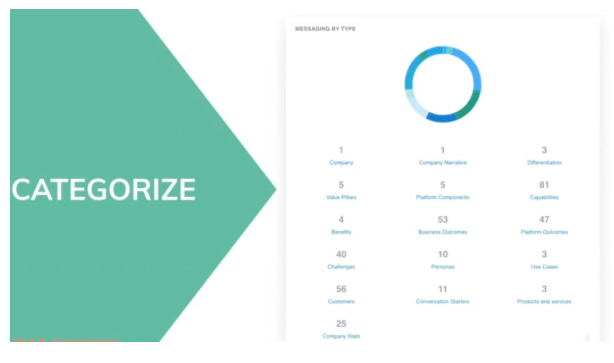
"You can see a level of hierarchy by the different levels, but also by the level of granularity of the different messages. For example, we only have one strategic company narrative but we have a few key customer benefits and a tonne of capabilities.
"What helped me build out this taxonomy was our customer stories. One of our values at Contentful is to start with the customer, and work your way back.
"So when building out my taxonomy, I started looking at all of our customer stories, our public-facing case studies, and I picked up on a few patterns which made me realize that our customers speak about the value we deliver in very different ways depending on which persona we're speaking to.
"This helped me identify KPIs can actually be split into two different buckets; business outcomes and platform outcomes, which are directly attributable to our platform."
Build your taxonomy around how people will use it
"When building out your messaging taxonomy, build it around how people will use it, understand common terminology used in your business, and build a taxonomy around that so people can find your messaging faster.
"Remember that time when someone asked you, "Where's that deck with that story about that customer and that really cool thing they did? I think it was something about speed and APIs? Well, I need it for a presentation yesterday".
"Typically, your brain starts to scan its own database and try to understand, is this the same story we're talking about? Are we really thinking about the same things?"
A taxonomy eliminates ambiguity
"Well, building a taxonomy will eliminate that ambiguity, and lets you filter down based on the key messages identified.
"I personally think creating a foundational messaging document is a great starting point. But then asking people across your business to go in this 20/30/40 page document (I hope yours isn't as long as ours is), asking them to go and control find and filter through this heavy document, I don't feel is user friendly.
"Instead, by organizing and categorizing messaging into certain buckets, you can make it easier to find based on the common terminology."
Pro tip
"A taxonomy should really be built with the future in mind in case you launch new products or services or lines of business. You will also want to make sure that it is flexible enough to update and layer on additional information and messaging as your business evolves.
"Talking about flexibility, let's go into the second principle around atomizing your messaging."
2) Atomize
"Atomizing your messaging is about breaking it down into small chunks. It's not just about parsing a PDF or Word document into sections. Atomizing is about turning your messaging into meaningful standalone bits that can be used anywhere in any context.
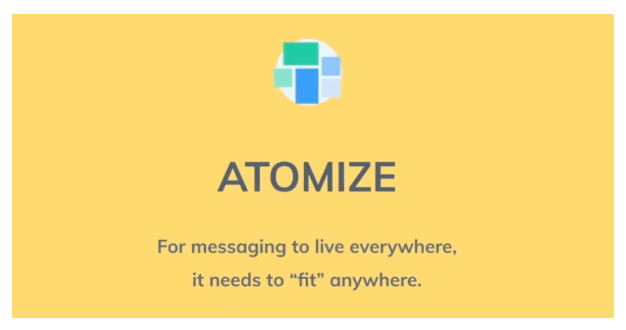
"You should be able to read it on its own and it should be self-explanatory and comprehensive."
Break down your messaging
"When you do this, what you'll want to do is break down your messaging and when you think you've broken it down enough, break it down some more. By doing this, you're creating messaging that is reusable."
"This is going to be a real-time-saver for you as a product marketer. This mindset is something content strategists evangelize because it makes content reusable and thereby also consistent.
"This is also something that Contentful pioneers in its create once publish anywhere approach. I have my employer to thank for helping me as a product marketer thinks about messaging in this way."
Messaging library
"Breaking it down lets you create a library of messaging to choose from that can be used dynamically in various formats and in different scenarios."
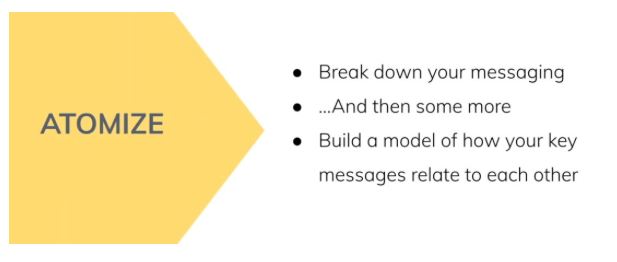
Build a model of how your key messages relate to each other
"An important part of this entire process is building a model for how messaging relates to each other. I was fortunate enough that my manager felt scaling messaging at this stage of growth of the business was important enough to invest software into."
GrokSpark
"So rather than creating these unwieldy long messaging docks that can quickly become outdated, we were able to invest in something called GrokSpark which is basically a messaging hub built by product marketers for product marketers.
"What it does is helps you build your messaging taxonomy, like I showed you earlier, and then atomize your messaging to start building a database.
"From there, you can make however many combinations you want, whether it's for sales enablement collateral, or for website or campaign briefs, and make sure your messaging is consistent across all of these different touchpoints."
Pro tip
"To round off, if you want your messaging to be used everywhere, you have to make sure to break it down into small chunks, so it can fit anywhere.
"My main tip here would be to have a multi-channel mindset for your messaging. Think of all the possible places where your messaging could live, such as your website, your podcast description, potentially even external review sites, on a mobile app, or in a CTA.
"You'll want to ensure you can add new information over time and as I mentioned, a live doc with view-only permissions is better than a PDF because a PDF will become quickly outdated and it's really hard to track if somebody has downloaded it at once onto their computer and you're not able to find and retrieve that to update it again.
"My last tip would be to make sure you have a way to assemble messaging. We use GrokSpark for this but you can also use a messaging library, deck, document, or sheet.
"With this approach to atomizing your content, you're bound to get more mileage from every bit of messaging you produce.
"You won't be creating net new every single time, it'll be more about putting the ingredients together than having to run out to the shop last minute, try to buy all the ingredients for a five-course meal, right when the shop is about to close. Nobody needs that kind of pressure.
"Now you've categorized and atomized your content, it's time to curate it."
3) Curate
"The last principle we're going to cover is about curating your messaging for audiences."
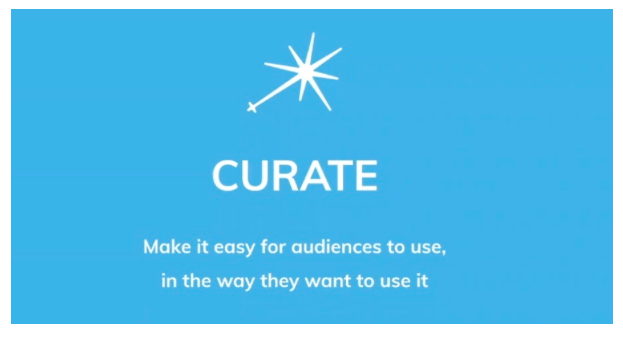
Tailor to your audiences
"When thinking about messaging for key stakeholders, it's a perfect opportunity to step back and do some discovery work to understand what your audience really needs.
"Investing in knowing your audiences, and walking them through what you have, all your categories, and all of the different messaging ingredients you have will help you understand how they envision using it in their daily operations. It will also make sure it's adopted.
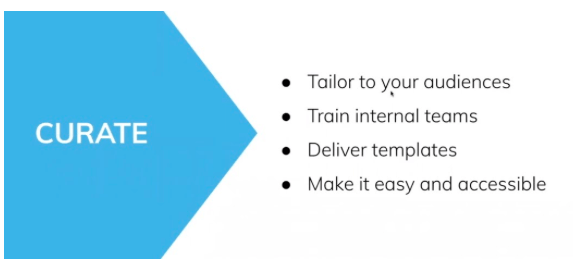
"At this stage of our messaging journey, I did three things that brought me back to my Optimizely roots.
"I segmented my audience into three groups based on the biggest impact. Sellers, because they have direct contact with customers. Marketing to drive consistency across channels. And our partner ecosystem that amplifies our voice and market.
"Then I did some research to understand how they're using messaging today.
"Finally, I built out some hypotheses and tested out the approach with focus groups. I shopped around for some templates, got feedback, did workshops, and landed on some key artefacts they can use in a self-serve way.
"We spun up messaging combinations literally in under five clicks, or in about 20 seconds, where you choose the messaging variables upon which you want to actually base your content.
"Remember that time when someone asked you "Do we have that customer story around scalability?"
"Because requests like this are unpredictable in the product marketing world, we should be prepared for any scenario and any messaging request for any audience. Creating and curating upfront will help with that process."
Partners
"For partners, we realized we needed to provide them with extra guidance around our messaging, and it's kind of like brand guidelines but it's really about our messaging and positioning.
"When one of our partners reached out to us thanking us for the messaging document we created, this is when I personally did a little happy dance.

"One of our partners wanted to use our messaging for a campaign they were working on. They didn't need all of our messaging details and everything, they needed a curated shorter version. We made this available via our partner portal.
"It's so rewarding to see our messaging is expanding beyond our four walls and into our partner ecosystem. The best part is that having this live link on our partner portal makes sure they always have our latest messaging and positioning, regardless of whether we update our tagline or boilerplate."
Pro tip
"At Contentful, we're in the fortunate position that we're the leading content platform that pioneered headless content management.
"But when you're going through this crazy rapid growth, you need to make sure your internal stakeholders and your external stakeholders have the latest and greatest messaging so they can evangelize it and amplify it in the market too."
Next steps
"As a next step, I'm really excited about continuing this messaging journey with different teams across the business, such as our sales engineering team who will help refine and further strengthen our messaging as well as our developer relations team who are already going into our messaging hub and helping us refine and prioritizing our messaging for certain audiences.
"All in all, messaging is a team sport, and I'm fortunate teams across contentful also see the importance of scaling our messaging consistently across the business."
Live vs. static
"My main tip for the curating part of your messaging is to consider how you can have a live link versus a static PDF that can become quickly outdated.
"See how you can drive adoption by building messaging templates that are self-serve, easy to edit, potentially with filters or dropdowns, so you can drive messaging adoption across your business."
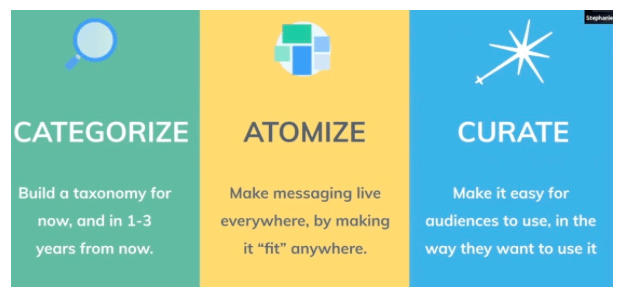
How to get your product's message out there
Once you have your messaging down, you need to start communicating it to your audience. There are a variety of different ways that you can do this. But one thing you must always keep in mind is how your audience wants to be communicated with.
Let’s take a look at some ways you can do this...
One example, as we previously mentioned, is actually using SMS marketing or digital marketing. Of course, this is only going to work for those who actually use social media or their phone a lot. Many companies actually have an option on their websites where the customer can opt-in for SMS or email marketing. This is a great way to ensure that you’re certain of how a customer wants to be communicated.
Here, they have the choice of giving you their phone numbers or emails, which you can then input into an automation tool like MailChimp to mass send your product updates and messaging.
Staying on the digital marketing side of things, you may like to add a personal touch to your marketing strategy and follow up with your returning customers on social media sites like LinkedIn or Facebook messenger to thank them for their purchase. Of course, this is only going to work if you’re a smaller business, as individual personalized messages wouldn’t work with a larger customer base.
Keep in mind that, as a product marketer, the customer always comes first. Choosing to communicate with your audience in a way that they prefer, and what also works for you is a great way of making them feel appreciated, ultimately increasing customer retention, brand reputation, and then overall sales.
Of course, texts and emails are more modern marketing channels. But, there are many other ways that you can communicate your product messaging to your audience. For example, in how you convey your product pricing, the design of your product, tv advertisement, and so on. You just need to find what works for you.
You’ll find everything you need in our product marketing messaging framework and templates to get you off and running.
4 ways to include product messaging in your content
Need more of a guide for adding product messaging into your content? Ceillie Clark-Keane, Senior Marketing Manager, Content and Engagement at Unstack, shares four ways to include product messaging in your content.
Document and distribute your messaging
"This is by far the most important tip: In order to ensure that your product messaging is included in the content, you need to document and share that messaging.
"Even more though, you need to make sure you’re sharing the messaging in the right format. Asking your writers to reference product pages? Not enough. Telling content marketers to review a product presentation? Not the most helpful. Instead, you need to create a message map for each of your products that is informative, up-to-date, and easily accessible.
"There are lots of formats you can use to create and distribute a message map, but a living document like Google Doc works well. Your message map should include:
- A description of the product
- A list of key product features
- A list of key benefits for each feature
- All target buyer personas
- All value propositions for the product
- All taglines for the product
- Any screenshot or images of the product
- Any design guidelines
"If that sounds like a lot to you—well, you’re right. But this is work that, as a product marketer, you’re doing anyway. Creating a message map and sharing it is essential for making sure your positioning is included in the content."
Explore the problems your product solves
"Identifying and talking through the problems that your offering solves is crucial for product marketers. If that information isn’t included in your messaging document—and, really, even if it is—make sure you’re talking through these details with your content marketing leaders. These problems are a great place to start brainstorming for related content ideas that can incorporate product messaging.
"Some of the best ways to brainstorm blog post ideas according to content marketing experts is to start with a problem. This could be a recurring complaint that customer support tosses to content; it could be an industry dilemma that bugs everyone; it could even be a problem that your own marketing team struggles with.
"Content that starts with a problem is successful because it presents a goal for the piece, an audience for the final product, and real-life stakes. Take advantage of this formula by suggesting the problems that your product solves for content ideas, and letting your team run with it."
Leverage your buyer personas
"Your company’s buyer personas should be well-known to everyone in your marketing team—or, ahem, your company. Make sure you’re using these personas to ground your product messaging and make this copy more accessible and more transferable to other marketing channels.
"For instance, while product marketers might use buyer personas to define value propositions and craft messaging that compel these users to buy, content marketers consider these buyer personas as ideal readers. They’ll take their motivations and interests as inspiration for content.
"If I were planning content for a software product that marketed to audio professionals, I would focus on audio education, audio software, and time management. And I might also create content around Tobi’s social motivations, like collaboration and working alone, both with industry-specific tips and more general guides.
"To ensure that product messaging appears in your content, make sure it’s grounded in your personas. That way, it’ll be clear where, when, and how to mention your product."
Keep your content marketing leaders up-to-date
"When I started working on content strategy, one of the first things I was tasked with was setting up a regular, standing meeting with our product marketing team. The agenda was simple: going over any product updates and reviewing the product roadmap.
"In this case, I could use the product roadmap to start assigning broadly related articles early. That way, when the time came for a product release, our blog would already have multiple pieces of content offering more information on a topic, providing opportunities to plug the product, and gaining authority in the rankings.
"Keeping your content team in the loop ahead of time—and even way ahead of time—helps you establish your blog posts as educational well before you start promoting, which is a significant influence on the decision to purchase."
How to update your product messaging
Louise Dunne, Head of Product Marketing at Linnworks, shares her insights into updating your product messaging.
Your strategy has changed
In terms of chicken and egg, strategy has to come ahead of defining positioning, honing in on value proposition, crafting compelling messaging and adapting per persona.
While strategy shouldn’t constantly be in flux, it will evolve in line with changes in the wider market. Every day businesses deal with acquisitions and mergers, evolving buyer needs and changing market conditions so if the business strategy has changed, it may also be time for an update to messaging.
Keeping track of changes in the market is already part and parcel of product marketing’s remit. Regularly analysing sales cycles, monitoring competitor activity through win/loss analysis and research and being in close contact with customers and prospects will help to keep a finger on the pulse of shifts in the market that may indicate it’s time to validate that your messaging is still resonating.
Market feedback says it’s time to switch up
You know you have great messaging when prospects understand and value your differentiators, and post-sale, customers are satisfied they are getting what they signed up for.
On the flip side, where these indicators of success start to slip, you may need to investigate what’s not working in your messaging. By researching your buyers, analysing opportunity data, speaking to customers and customer-facing teams, and looking at touch points across the entire customer journey you can build up a better picture of the accuracy and efficiency of messaging.
Having a quarterly cadence to review key data points on sales cycles, buyer persona feedback and customer feedback will help identify opportunities to course correct messaging and positioning.
Sales adoption is low
A sign your messaging is resonating with buyers is that your sales reps are using on-brand messaging consistently, adopting key assets without making significant updates and that sales cycles progress at a reasonable pace.
Where you might have an issue is when you find sales teams creating alternative talk tracks, developing custom content for their sales cycles and veering off messages when presenting to customers and prospects in order to advance them through deal cycles.
The first step is to diagnose the problem, whether it’s a sales confidence issue, which will require a different approach to instil best practices and reinforce enablement, or a messaging issue.
Gathering sales feedback on the lightbulb moments in pitches and demos, shadowing opportunities live or watching back recordings and analysing sales data will help gauge how messaging is being received in the market.
It’s important for product marketers to deep dive into active sales cycles on a regular basis, whether it’s researching a particular segment, region or buyer persona. Either way, finding the blockers where customers don’t understand the value, where there are repeat sticking points and where further customer education is needed will help inform messaging and content requirements.
Your product has changed
Product evolution also has an impact on messaging and positioning. Will a new feature allow you to reach new users and use cases? Will enhancements to your product or services mean you can differentiate against new competitors?
As you go through the go-to-market process, it’s worth factoring in how this changes your competitive positioning and how this translates across all customer-facing touch points from marketing outreach to public messaging to sales enablement resources.
Constantly querying how your roadmap impacts downstream positioning and messaging will help avoid gaps in how your product and solution is perceived in the market.
As part of go-to-market plans, make sure to add steps to review externally facing assets from the website to sales presentations and refresh messaging as and when needed.
Access this complete toolkit - and more - right here. 👇
Whether you've got a messaging overhaul on the horizon or just want to brush up your knowledge and learn from the best for when the time does come, here's a selection of presentations, templates and guides to help you through your next messaging project.
Part 1: presentations
- Don't NOT talk about features
- Product messaging: a taxonomy AKA the decoder ring
- Results of a COVID-19 messaging refresh
- SurveyMonkey's 7-step messaging process
Part 2: templates
- Storytelling framework [template]
- Storytelling framework [example]
Part 3: messaging guides
- TL;DR: simplifying your message for maximum impact
- Product messaging - the difference between good and great
- Establishing and developing product messaging
- How to make your product messaging pop
- Write your CMO ticket - remove the guesswork from messaging & positioning
There's plenty more where this came from. 👆
Unlock it all in here. 👇


Get Messaging Certified 👇
By the end of the Messaging Certified: Masters you’ll:
- Know how to build foundations for solid messaging and customer engagement
- Be able to get maximum impact from your product marketing messaging frameworks
- Be a pro at drafting, layering, and reviewing your messaging
- Understand how to work more effectively with copywriters
- Know how to validate your messaging with prospects and customers
- Understand message synching and why it matters


 Follow us on LinkedIn
Follow us on LinkedIn

